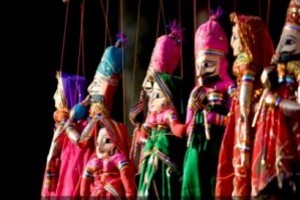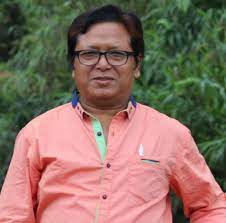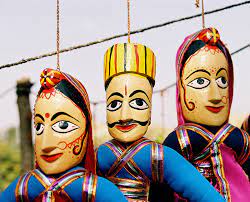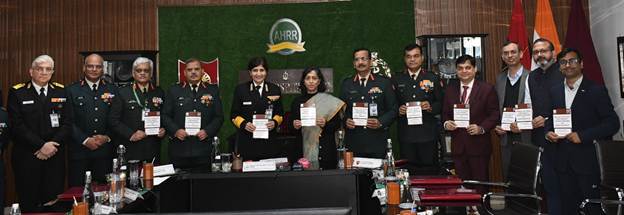

By Dr. Jagadindra Raychoudhury*
Puppetry (Putola Nach) theatre is a traditional string theatre which had been very much popular not only in Assam but also in the entire northeast India since the time immemorial. “Putola Nach” was one of the most popular forms of entertainment especially amongst children. Though the Putola Nach (Puppetry) is familiar in Assam but the concept of its performance was well known since the time of Mahabharata era. According to the ancient oral myth of puppetry, Goddess Parvati once created a beautiful puppet secretly and hid it inside a cave, so as to avoid any misfortune to the puppet. Lord Shiva, in due course of time gave life to the puppet as being fascinated by it. The puppet started dancing after getting life and Lord Shiva sent the puppet to the earth for giving entertainment for the human. This oral myth on puppet was based on ancient perspective.

Putola Nach, which is already mentioned as an ancient traditional folk theatrical performance of greater Assam. The performance can said to be well acclaimed as it is the world’s most ancient figure of folk drama. The drama was well performed across Assam and much admired in some place like Makhibaha, Muhkholi, Chandokusi, Tihu, Bhekuli and Piplibari. In Darrang district, it performed in Sipajhar and Kolaigaon and districts like Nagaon, Jorhat, Golaghat and Majuli, especially in Kamalabari Satra, Auniaiti satra, the performance of Putola Nach is highly praised by the outsiders for its wonderful performance.
The Putola Nach has to be performed with skillful hands because the lifeless puppets are turned to be a living one on the hands of sutradhars (Puppeteers). Normally they play these dramas based on certain scripts with different story-lives, songs and dances containing some background music. The Sutradhar is using puppet which are attached with some rods, strings and wires. These supporting equipment are invisible for the audience because lighting systems is so well set that the audiences are unable to differentiate the puppets with strings.
Traditionally, in Assam the Putola Nach can be classified into two categories. The first one being Moukhik porompora (oral tradition) and the second one is Likhit porompora (written/ recorded tradition).
Moukhik porompora is traditionally transformed from ancient time to the present context mainly orally. It carries some stories which a few historians have recognized it as myth as how Parvati and Shiva prepared a puppet and sent to the earth for entertainment after giving life. Another customary that was practiced by the farmers by hanging his own image in an around the fence and used to sprinkle flowers, fruits along with the ashes from the cremation ground in order to avoid misfortunes to show devotion to the evil. These kinds of arrangements are especially done to avoid unpromising look of different people, wild animals and birds etc. The puppets or human like puppets are generally used for some kinds of witch crafting. This kind of activities is basically done through oral tradition which transformed from one generation to others. Another ritual customary that still prevails in our society is by creating puppets made up of kush grass and are being offered for dakhapina ( Hindu people use this on the ten days following the death of a person). Putola Nach was basically based on some folk stories which were transmitted through spoken word (kothito). Many historians and research scholars believe that Devorshi Narad was the first storyteller. The oral transmission of some folk stories are focused with the help of Putola Nach and categorized as moukhik porompora.
Likhit parompora (written tradition) of Putola Nach is not exactly determined by its time as it had a long back documentation since the time of Vedic era. The tales about putola obhinoy is especially mentioned in Kalikapurana, which was composed in Kamrupa in eleventh century. In Kalikapurana, with the help of the word ‘Panchlika’, the tales of Putola Nach have also been described. Some research scholars claim that Putola Nach is more ancient drama than Ojapali. According to them, Ojapali is some changes of Putola Nach. The Putola Nach in the undivided Kamrup District of Assam was known as Botris or Boti Putola. It was also mentioned in the ‘Dakrinngso Puttolika’ narrated by Sanskrit playwright, Boruchi, the tale of 32 puppets telling instructive stories to king Vikramaditya.
In Darrang District, Puppets are also known as ‘Jaal Puteli’. The word ‘Jaal’ means fake which means puppet is not humans on the contrary puppets are mentioned as the copy of human. Actually lifeless puppets become alive by the expertise direction of human’s skillful hands. The Khutradhar or Putola Bajikor were called as ‘Taatokiya’ especially in the middle age. The word ‘Tatokia’ was also mentioned by Srimanta Sankardeva in his Bhagawat Geeta.
In Assam, Putola Nach was known with different names, such as ‘Khel-dhemalir putola’ (playful puppets), ‘dhormo khongkrantiyo putola’ (religious puppets) and ‘nrittor putola’ (danching putola) etc. The khel- dhemalir putola includes both human and animals with well dressed as like as idols of God- Goddess. Dharmo khongkrantigo putola narrated some stories based on religion whereas khel-dhemalir putola expressed varieties of games.
Besides these some other Putola Nach are also performed in Assam by the sutradhar and these are —- ‘Aanguli Putola’ which is also popular in some parts of India. These putolas are without limbs. ‘Haat putola’ is another puppetry which is especially performed its arts using hands. ‘Khuta Putola’ is very much common in different parts of Assam where puppets are thin but strong and are manipulated in the drama by the puppeteers from behind the stage with the help of yarn or rope. There is another putola called ‘Laathi Putola’ which is also very much common in Assam. Here, the puppets are made to move with the help of rods (laathi) from underneath the stage. The bamboo or the wooden rods remain hidden under the puppets which make the performance of puppet much easier for sutradhar. The varied Putola Nach have some of its specific significance but the theme of almost all Putola Nach (puppetry) of Assam is based on the story of Ramayana, Mahabharata and Puran etc. along with some strains based on present social life.
There is another Putola Nach , called ‘Kukhan Gaan’ and ‘Putola Nach’ which is very much popular folk drama of undivided Goalpara District. There is a specialty of this drama where songs along with dance are performed based on folk tales. The performance of Kukhan Gaan has succeeded to protect its own characteristics. Kukhan Gaan is also said to be the oldest form of Ram Yatra. It is to be mentioned that the saint Valmiki taught Laba and Kusha the tales of Ramayana and which was periodically performed in front of Lord Ram. The Kushan Gaan was also included with some other stories like ‘Ravan bawdh’ and ‘Daani Raja Harischandra’. In Kukhan Gaan , altogether 5 to 6 artists are witnessed as co-workers with the Putola Bajikor. The musical instruments which are used in Kushan Gaan have some special quality like Veena, Dotara, Sarinda etc. are invariably used by puppeteers. Kushan Gaan can be compared with Putola Naach because of its similarities and mainly performed during Puja and any other special public gathering.
Putola Nach is an oldest outward appearance of drama since the time of immemorial where religious or social tales are performed with very expert skilled hands. The Putola Nach drama is more attractive with songs and musical performance and it was very much popular across Assam but the present situation seems to be pathetic because the well acclaimed puppetry is now in the verse of extinction. So, the conscious citizens as well as art lover’s people of Assam should extend their profitless efforts to revive our ancient puppetry theater to a larger extent. Our traditional best works in the field of art and culture should be preserved and the flow of its continuity should be remaining in a vibrant condition for our future generation.
Educationist and writer.





